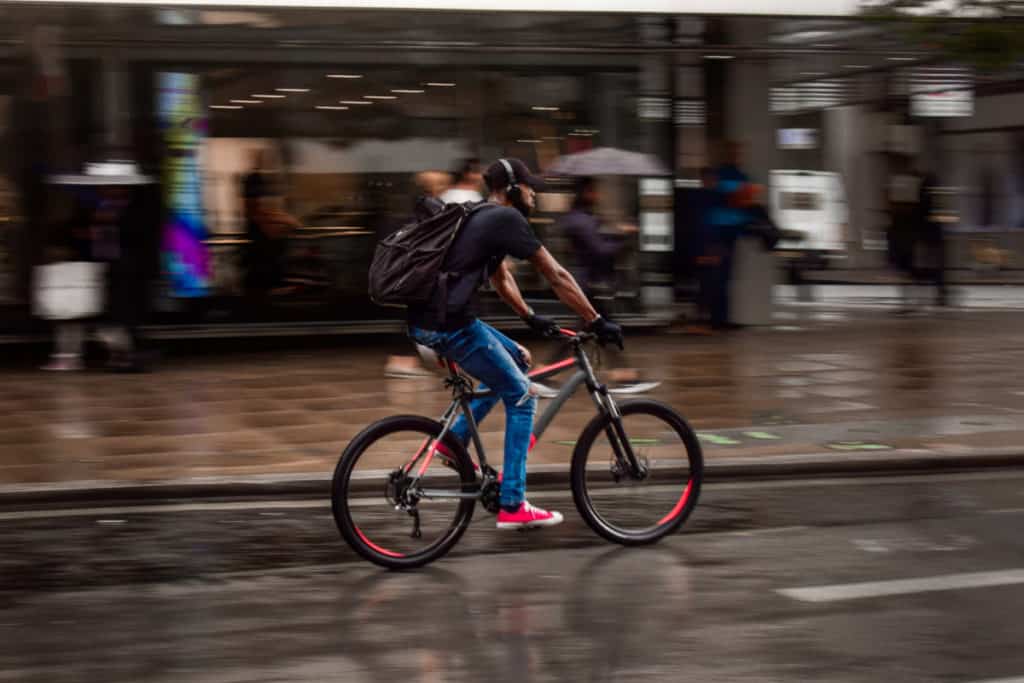
Commuting to work is a way of life (unfortunately you may say) but no matter what job or career you do, chances are you have to get from your home, into a designated workplace and back again for the majority of your working week.
Of the alternative ways to commute without a car, bike commuting, walking, running and public transport amongst the most popular. These are the methods suited for most people, but there are other alternatives that could be considered.
Here at True Commuter, we like to promote healthier and greener transport methods for your day to day commute. If we all look to leave the car at home, even for one day, opting for greener methods we can make a significant improvement for the environment. Passenger cars are a major polluter, accounting for approximately 60% of total CO2 emissions from road transport in Europe.
We are passionate about making small daily lifestyle habit changes, that when aggregated over time can make a huge difference to your health, the environment and your wallet.
According to the RAC, there are 26.5 million working people aged 16 – 74 in England and Wales. Of these, 16.7 million people either drive themselves to work (15.3 million) or catch a lift (1.4 million).
In rural areas, nearly three-quarters of workers travel by car. This method of travel also dominates the commute in urban areas (outside of London) with 67% of people either driving themselves or catching a lift. Even amongst Londoners, the car is the most popular single mode of travel, used by 29% of workers.
The average length of a commuter trip by car/van varies little across English regions and Wales at about ten miles. It is highest in the South East (11.2 miles) and lowest in London (8.6 miles), these average distances are all very achievable with alternative commute methods without a car.

In this article, we explore the many alternative methods of commuting without a car to give you the inspiration to try some. Leaving the car at home when you commute can open up access to a world of benefits such as increased fitness, improved physical health and wellbeing, improved mental health and stress resilience, reduced costs and environmental benefits to name a few.
Who knows? Commuting without a car may even open up the option for you to ditch the car completely, learning to manage without it or, for many families may lead to an option to reduce the cars in the household from two to one yielding a great annual cost-saving and improving the health of the entire household.
If this piques your interest and curiosity, then read on, we have many alternatives described in this article, you don’t have to opt for the obvious ones, some commuting methods can even be fun. When we were kids, we used to love getting out on our bikes, for example, it is only as adults we decided that commuting had to be a time of misery and not a time of fun, it is time to change this belief!! Below is an outline of the methods we explore in this article.
- Bike Commute
- Walk to Work
- Run to Work
- e-Scooters
- Roller Skates / Inline Skates / Boarding
- The Segway
- Take Public Transport to Work
- Car Sharing
- Avoid the Commute – Remote Working
- Multi-Modal Commuting
Bike Commute

Of all the alternative methods, bike commuting is one of the most popular, and it is easy to see why. Bike commuting gives the advantage of speed to your commute over some of the others. If your normal driving route has you standing still in traffic, you may be enviously looking around at all the bike commuters passing you by. Personally, my bike commute only takes 10 minutes longer than my car commute.
The time taken to bike commute is also very predictable and is not impacted by traffic, road works or other road incidents meaning you can plan your day much more consistently. You also get the added benefit of fitting in a good daily dose of exercise in the time you would usually be sat in your car.
Bike commuting is great for general health and is a great option for the majority of people, irrespective of current fitness level, body composition, weight or strength. Cycling is low impact, so is suitable for people with joint or muscle issues and can be tailored for your fitness level, you can easily dictate the level of effort you choose to put in. Most people can cycle at a moderate pace for 30-60 minutes without too much training or without too much trouble.
As seen from the statistics from the RAC the average commute distance is approximately 10 miles (16 km) which is easily achievable by bike for most people and can be achieved quite comfortably in 50 minutes. If your car commute takes you on busy routes, you may endure a longer commute due to traffic and other road issues.
Bike commuting is becoming more and more affordable too, with incentives offered by many schemes such as Cycle Scheme, meaning you can purchase all of the equipment you need to get started TAX-FREE and pay for it from your pay each month at a fraction of the cost without the scheme. These schemes allow you to buy your commuter bike, safety equipment, such as helmets, lights and bike locks, clothing and any other accessories within the scheme and so these schemes can be the one-stop-shop to get you up and running.
In order to get started with Bike Commuting, check out our ultimate beginners guide here.
Walk to Work

An often overlooked method of transport for an alternative commute is our legs and walk commuting is an option open to many people. The benefits fo walking is that you do not need to invest in any gear (apart from comfortable footwear) and can start right away. Walking is also a low-intensity option and so you will NOT arrive at work all hot and sweaty and needing to shower which means it is an option irrespective of the facilities you have at work.
If your commute distance is reasonable, you can definitely walk to work. At an average walking pace, 4 miles (6.4 km) will take approximately 1 hour, potentially a shorter time than your current car journey with bad traffic but however long your commute takes, walking can have significant benefits and advantages.
Walking can sometimes be an overlooked form of exercise but can bring a whole host of benefits from building stamina and burning calories to making a significant contribution to a healthier heart. It is a great way to become more active generally so why not bake this simple fitness into your normal, daily commute. This will be a massive beneficial long term habit.
According to Walking for Health, in older people, staying active can improve cognitive function, memory, attention and processing speed, and reduce the risk of cognitive decline. It really is a good thing for everyone!
Walking is a great way to commute but it does favour people living within a couple of miles of the workplace, otherwise, commute time is increased fairly significantly and could become too much of a time burden. However, if you want to commit to alternative commuting, walking can be a great way to mix it up, increase the daily step count and yield health benefits in abundance!!
Run/Jog to Work
Running to work brings all the walking to work benefits but will reduce your commute time, plus the increase heart rate will help to burn more calories over a shorter period of time and contribute faster improvements in general cardiovascular fitness.
However, running does put more strain on your muscles and joints and is much more physically demanding than walking and cycling which offer the benefit of being low impact and allowing you to easily pick it up quickly and complete the commute despite your fitness level.
This is where running becomes more specialised. If you haven’t run in a long time (since childhood for example like many adults) then you will need to build up to your commute distance, or any significant distance for that matter. The impact on your joints and muscles when you run could cause injury if you don’t build up and strengthen muscles over time. If your run commute takes you on hard surfaces, such as pavements and roads, then the impact could be severe if you are not used to running on such surfaces.
If you have a 5-mile commute that you just can’t manage on day 1, then start by running part of the way and build up over time. If you are completely new to running then it is advisable that you train a little before starting to commit to your commute run.
Another option is to run and walk over your commute distance. Mix both forms of the commuting method up a bit to help you to build up the fitness and reduce your walking commute time. This method of training can build your fitness quickly and is the method adopted by programmes such as ‘Couch to 5k’. Check the video below out for more information of this training method.
The problem with running is you will definitely get hot and sweaty, even on a cold day. This means shower facilities are essential at your place of work, no amount of wet wipes will help after a hard run.
The key to running to work is getting appropriate footwear. Spend some cash on this and don’t go cheap, the better the footwear, the more protection you will get from running impact, protecting your bones, muscles and joints which is key to your running success.
e-Scooters
For some, biking is the main commuting alternative of choice, but biking to and from work can get exhausting and may not work for everyone. That’s where electric scooters come into play. Scooters are not just for kids. Adults can get in on the fun too, no one said commuting had to be boring.
e-Scooters are a compact, easy way of getting two and from your work without having to worry about a bulky bike and are also a leisurely, and really fun, way to get around.
Scooters operate on batteries that can be recharged and can often reach speeds up to 20 mph (32 km/h) which means you can cover more ground over a shorter time when compared to other methods of commuting. Great for reducing the time of slightly longer commutes.
The issue with e-scooters is in the legal use of them as a road vehicle. The UK’s Department for Transport has launched a review into the future of urban transport. It says, “People who use e-scooters need to be aware it is currently illegal to ride them on the pavement and the road. Whilst this is not currently enforced, and there are some grey areas, the increased popularity and use of e-Scooters will likely bring restrictions, especially if they become dangerous to other road users or pedestrians.
Depending on your commute route, you may be able to take advantage of the e-Scooters on offer but make sure you check local laws before committing to this mode of commuting.
Roller Skates / Inline Skates / Boarding

Not for me personally, you have to be way cooler than me to skate or board, and much more well balanced too, but this could be a great option for you. You could re-ignite a childhood passion and get a healthy dose of cardio and spice up your commute in the process.
Skating and boarding is lower impact and easier on the knees and joints than other forms of activity, such as running, but has all the cardiovascular fitness benefits. A 30-minute glide can also burn up to 250 calories so can really contribute to your fat loss goals and generally increase your physical fitness. As with any exercise, there can also be mental health benefits too.
This method would likely be slower than cycling generally but brings more choice to your commute route, you can skate on pavements and through pedestrian areas which makes them versatile and allows you to take a more direct route to work, especially if you live and work in a town or city centre.
The downside with skating is the need to remove them once you reach your destination and so you always need spare shoes, but this is usually the case when you arrive as work through any alternative commuting method, I am not sure cycling shoes would go well with your Hugo Boss suit in the office.
The Segway
I am sure you will recall the day we saw our first Segway. What was this mystical transport method? The upright, anti-gravity vehicle looked like something for science fiction. This led to many wanting to try these crazy machines for themselves and the Segway ‘experience’ day was born meaning to ride a Segway across the countryside at leisure. Since the launch in 2001, the Segway has somewhat had a fall from grace.
Production on these vehicles halted in 2020 unfortunately so you may be able to purchase a cheap one-second hand to take advantage of for your commute. Either that, or they will become super collectable and cost a fortune so, if you have one, stop commuting on it and put it somewhere safe until it is an antique!!!
A nice alternative commute option, but time may have run out for the poor old Segway.
Take Public Transport to Work
Public transport, while it has its faults, can be a great way to commute and many don’t even consider it due to the image it presents. Busses and trains are seen as dirty and uncomfortable and yet this can be true but many networks are constantly upgrading their vehicles.
Public transport brings many added benefits such as being able to read, listen to a podcast or watch the latest episode of a cool show en route, your time is your own. Most public transport options now will offer free wi-fi allowing you to turn your commute into productive time for business or pleasure.
The downside, you are in the hands of the transport providers, with cancelled services, delays and other issues being very frustrating and messing up your day’s plans either with work commitments or home commitments, but this is no different than driving and coming across an accident that delays you. If you are using the roads you are likely to face delays from time to time despite your choice of vehicle.
Public transport is likely to be cheaper than a car for commuting or short local journeys, which is not always evident on the face of it. When comparing costs, remember with a car you need to allow for running costs over the year as well as fuel. So it’s well worth considering buying a weekly or monthly season ticket for bus, train, tube or tram instead.
If you can use public transport to remove a car from a household, this could provide considerable annual savings for the family as well as significantly benefiting the traffic and environmental problems.
Public transport often means you have additional travel to get to the transport hub from home, and then to the office from the transport hub at the other end. This can be seen as a real drag, increasing commute time and cost but this can be turned into an advantage. Adding a short walk or cycle to and from the hubs can have a massive benefit on your overall health and so this type of commute may be ideal for you.
Find out more about your public transport options at websites such as:
- England, Wales and Scotland National Rail Enquiries
- London area – Transport for London
- Northern Ireland – Translink
You could also consider a taxi or an Uber for your commute. Not quite public transport but, with convenient apps allowing you to order private hire vehicles at the click of a button, this could be an efficient way of commuting. As you are not hanging around for a bus or a train yo will save time on your overall commute time.
You are not really getting much benefit here though with regards an alternative commute. You will remove the need to service and maintain a car but this option is likely to be more expensive over time. You also still contribute to the traffic, have exactly the same carbon footprint and face all the same delays than if you were to drive yourself. You also remove the health benefits from the equation.
The way you could utilise this as a healthy alternative commute method is by commuting part of the way with an alternative method, such as bike commuting, and have an Uber meet you somewhere on the journey, shortening your commute time.
Combining these methods will also make the physically demanding commute method much more manageable in the short term, while you build your fitness and reducing the time taken to commute for longer distances.
You can check out this article about taking your bike in an Uber.
Car Sharing

Modern cars could be among the cleanest modes of transport if shared, rather being driven alone and you can ride your commute with good company and share the overall costs. Car sharing schemes are becoming more popular.
Car sharing may be formal, using an organised car share scheme such as Liftshare, or informal – for example, friends or colleagues travelling to work together. Many companies help to facilitate car-sharing with car-share registers and encouragement. If your company doesn’t offer help here, then why not start something?
If a straightforward lift-share won’t work for you, why not consider Park and Share? Take your car or public transport from home to a central destination where you meet up with other car sharers to finish your journey. You can find more information on the Park and Share page.
Car sharing can, quite literally, half the number of cars on the road bringing major improvements to congestion, road rage incidents and emissions.
Avoid the Commute – Remote Working
Remote working is becoming more popular, not only does this save you a number of commutes per week, but it also gives you more time to work and add value to your company. It should be seen as a win-win but often isn’t by many companies, particularly more traditional ones.
Allowing remote working requires a shift in attitude by the leadership, who need to cultivate a trusting and open culture to enable remote working success.
Remote working has been proven to imporve work-life balance, reduce stress and improve overall productivity and so has many benefits for employer and employee alike.
If this is something you want to consider, it is built into UK legislation that any employer has to listen to your requests for flexible working and be supportive where they can. This is not well publicised but you have a legal right to request flexible working. The type of work needs to allow this to be an option but for many office workers, this can become reality.
Companies are becoming more aware of the benefits, especially in a post COVID era and so if this is not offered, it would be worth a conversation to see if they would support you in remote working.
All of the Above – Multi-Modal Commuting
Perhaps the best of all, is that there is nothing stopping you choosing a number of methods. We have already discussed the walk/run combination but what other creative ways can you combine commuting methods?
You could drive part of the way and cycle the rest. You could run to the bus stop or train station and then run to work at the other end. There are lots and lots of combinations here which could work for you so it is worth considering and trying a few to see what best works for you.
Summary
This article gives you so many alternative commuting ideas that there really isn’t an excuse not to give it a go. We have not only shown you methods that can improve fitness, help the environment and save you money, may of the methods rekindle the childhood spirit and will make your commute fun!!
No one ever said a commute couldn’t be a fun part of your day. It is us boring adults that made it so. Why not go against the grain and be in the minority of people who actually look forward to and benefit from their daily commute!!!
Join the Revolution!!!! Become a True Commuter!!!
